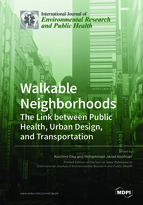Walkable Neighborhoods: The Link between Public Health, Urban Design, and Transportation
A special issue of International Journal of Environmental Research and Public Health (ISSN 1660-4601). This special issue belongs to the section "Health Behavior, Chronic Disease and Health Promotion".
Deadline for manuscript submissions: closed (30 April 2019) | Viewed by 67590
Special Issue Editors
Interests: sedentary behavior; behavioral epidemiology; behavioral science; built environment; physical activity; workplace
Behavioural Epidemiology Laboratory, Baker Heart & Diabetes, Melbourne, Australia (Honorary)
Interests: urban design; population health; neighborhood; environmental health; workplace; active living
Special Issue Information
Dear Colleagues,
It is now widely recognized that individual-based motivational interventions alone are not sufficient to address the global pandemic of physical inactivity (lack of exercise and too much sitting time). There has been a growing interest in the role of the physical built environment on people’s active behaviors. The fundamental assumption is that surrounding physical environment can support active behaviors among a large number of people with long-term effects. This topic has received much attentions over the last decade, mainly in three fields of public health, urban design, and transportation.
This Special Issue aims to provide a multidisciplinary and evidence-based state-of-the-art on how where people live impact their active behaviors and health outcomes. For the purpose of this Special Issue, the focus is on the “physical” (not social) aspect of the built environment at the spatial scales of public open spaces, neighborhoods and cities (not buildings/workplaces). We are particularly interested in the following topics:
- Terminologies and definitions: Active-friendly neighborhood, walkability, walkable environment, pedestrian-oriented development, bikeability.
- Cross-sectional and longitudinal studies on the role of physical environment on active behaviors and health outcomes among vulnerable groups (e.g., kids and older adults, lower socioeconomic groups) and in under-studied contexts (e.g., Asian and African countries).
- The mechanisms through which walkable neighborhoods influence health outcomes (such as obesity, diabetes, blood pressure, cardiovascular diseases, etc.).
- Measurements development: Neighborhood definition, objective or subjective measures of built environment, activity space and GPS, audits, challenges in developing walkability measures.
- Health disparities: The role of walkable environments on disparities in physical activity/sedentary behaviors.
- Unintentional negative effects of walkable neighborhoods.
- Cost-benefit analysis of active-friendly neighborhood design.
- Implementation: How to translate active living science into urban design and transportation practice, developing new walkable neighborhood indicators, walkable neighborhood guidelines, successful case studies.
The main article types are as follows: original research (article), review, and commentary. We welcome studies from different disciplines such as public health, urban design, transportation, sport science, kinesiology, epidemiology, geography, and landscape architecture.
Prof. Koichiro Oka
Dr. Mohammad Javad Koohsari
Guest Editors
Manuscript Submission Information
Manuscripts should be submitted online at www.mdpi.com by registering and logging in to this website. Once you are registered, click here to go to the submission form. Manuscripts can be submitted until the deadline. All submissions that pass pre-check are peer-reviewed. Accepted papers will be published continuously in the journal (as soon as accepted) and will be listed together on the special issue website. Research articles, review articles as well as short communications are invited. For planned papers, a title and short abstract (about 100 words) can be sent to the Editorial Office for announcement on this website.
Submitted manuscripts should not have been published previously, nor be under consideration for publication elsewhere (except conference proceedings papers). All manuscripts are thoroughly refereed through a single-blind peer-review process. A guide for authors and other relevant information for submission of manuscripts is available on the Instructions for Authors page. International Journal of Environmental Research and Public Health is an international peer-reviewed open access monthly journal published by MDPI.
Please visit the Instructions for Authors page before submitting a manuscript. The Article Processing Charge (APC) for publication in this open access journal is 2500 CHF (Swiss Francs). Submitted papers should be well formatted and use good English. Authors may use MDPI's English editing service prior to publication or during author revisions.
Keywords
- Walkable Environment
- Physical Activity
- Sedentary Behavior
- Neighborhood
- Health Outcomes
- Walkability
- Health Disparity
- Active Living
- Parks
- Public Open Spaces






